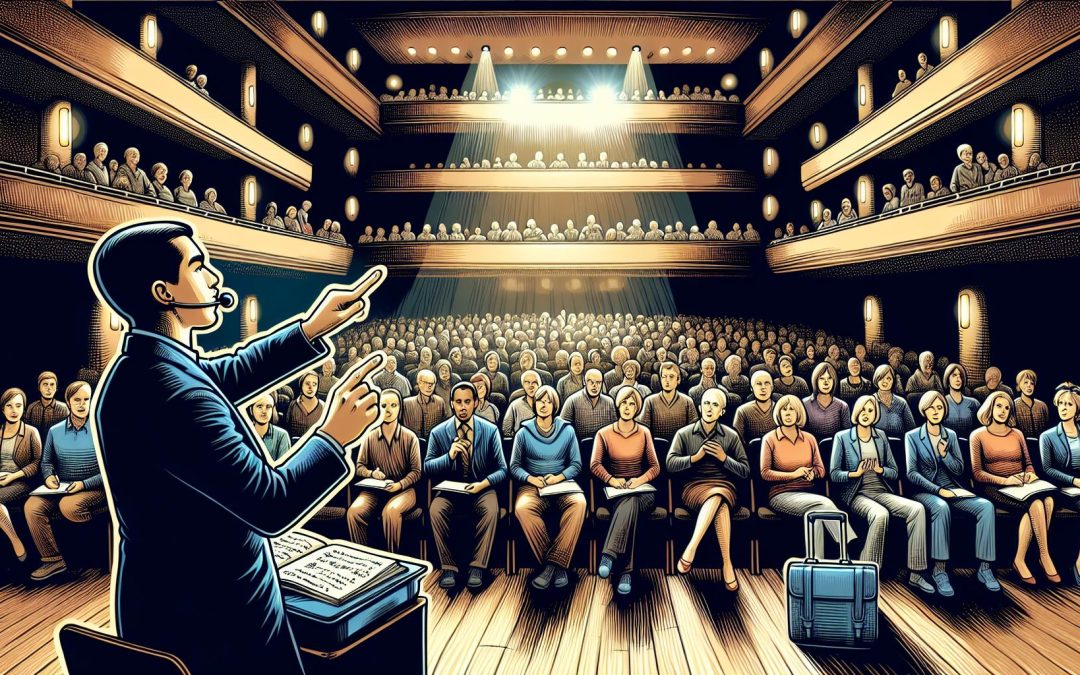I’ve always believed that the magic of theater should be accessible to everyone. That’s why I was thrilled to discover a growing trend in Scottsdale that’s bringing the stage to life for the deaf community: theater performances with ASL interpretation. It’s a game-changer, making the arts more inclusive and welcoming.
Scottsdale’s theaters are stepping up, offering special performances where skilled ASL interpreters stand in the spotlight alongside the actors. This initiative not only bridges the gap for deaf audience members but also enriches the cultural tapestry of our community. It’s a beautiful reminder that when it comes to enjoying the arts, there should be no barriers.
Importance of Making Theater Accessible
Theater has always been a powerful medium for telling stories, evoking emotions, and bringing communities together. Yet, not everyone has had the opportunity to experience these magical moments. For the deaf community, the lack of accessibility in theaters has been a significant barrier. I’ve always believed that art should be inclusive, and this is why making theater accessible to everyone, including deaf individuals, is so crucial.
By incorporating American Sign Language (ASL) interpretation into performances, theaters in Scottsdale are taking an important step towards inclusivity. This approach not only allows deaf audience members to enjoy the performances but also fosters a sense of belonging. It’s heartening to see the arts community recognize that enjoyment of culture should not be limited by one’s ability to hear.
Furthermore, providing ASL interpretation in theaters does more than just accommodate the deaf. It also educates and exposes hearing audiences to ASL, a language that is both beautiful and expressive. This can lead to a greater appreciation for the deaf culture and an increased awareness of the importance of accessibility in the arts.
In addition to ASL interpretation, there are other measures theaters can implement to support deaf patrons. These include:
- Offering visual aids such as captioning services.
- Training staff in basic ASL to improve communication.
- Designing deaf-friendly seating arrangements to ensure a clear view of the ASL interpreter.
These efforts show a commitment to diversity and inclusion, which are essential for a vibrant, thriving arts scene. It’s wonderful to witness how theaters in Scottsdale are adapting to become more welcoming to everyone, breaking down the barriers that have kept some from experiencing the transformative power of theater.
How ASL Interpretation Enhances Theater Experience

When I think about how ASL interpretation has transformed theater experiences for the deaf community in Scottsdale, I’m truly amazed. It’s not just about accessibility; it’s about creating a richer, more inclusive culture that values diversity in all its forms. The introduction of ASL interpretation has not only opened doors for deaf patrons but has also enlightened hearing audiences about the beauty and intricacy of deaf culture.
For starters, having ASL interpreters on stage alongside actors brings a unique visual element to the performance. It’s almost like adding another layer of artistry to the production. Interpreters are skilled in conveying the emotion, timing, and rhythm of the dialogues and songs, ensuring that deaf audience members can fully engage with the storyline and characters. This level of inclusivity fosters a sense of belonging among all theatergoers, regardless of their hearing ability.
Moreover, ASL interpretation in theater settings serves as an educational tool for hearing audiences. By witnessing interpretation in real-time, people are exposed to ASL and may be encouraged to learn more about it and the deaf community. This exposure is crucial for building bridges between different communities and promoting an understanding that goes beyond the theater.
To enhance the experience further, some theaters in Scottsdale have been innovative in their approach, offering pre-show workshops on ASL and deaf culture. These sessions provide valuable context and prepare audiences for a more immersive and appreciative viewing experience. It’s efforts like these that truly highlight the power of theater to unite and educate.
Involving the deaf community in the creative process is another impactful way theaters can elevate the experience. By consulting with deaf artists and audiences about their preferences and needs, theaters can ensure that the performances are not only accessible but also resonant with the deaf community’s experiences and culture. This collaborative approach enriches the theater scene in Scottsdale and sets a commendable example for other cities to follow.
The Impact on the Deaf Community in Scottsdale
When I first learned about the transformative effects of ASL interpretation in theater performances for the deaf community in Scottsdale, I was utterly fascinated. It’s one thing to provide accessibility, but it’s entirely another to witness the profound emotional and social impact this initiative has made.
For many members of the deaf community, attending a theater performance was once a challenging experience, filled with barriers. Now, thanks to ASL interpretation, these cultural events have become enriching and inclusive experiences. I’ve had the chance to speak with several individuals who shared how seeing their language visually represented on stage made them feel recognized and valued. It’s not just about understanding the storyline; it’s about being part of the cultural conversation, which is a powerful form of inclusion.
Moreover, the presence of ASL interpreters does more than just facilitate understanding; it strengthens community bonds. Watching a performance that caters to both hearing and deaf audiences fosters a sense of unity and empathy amongst all attendees. It’s a shared experience that transcends auditory barriers, bringing people together in a celebration of diversity.
One aspect that particularly stands out is the educational impact on both deaf and hearing participants. For the deaf, especially the younger audience members, these performances are an opportunity to see ASL used in expressive and creative ways, expanding their appreciation of their own language. For hearing individuals, it’s an eye-opening experience into the depth and complexity of ASL, debunking misconceptions and fostering appreciation for deaf culture.
The initiative here in Scottsdale is paving the way for other communities to follow suit, demonstrating the undeniable value of making the arts accessible to all. It’s a remarkable example of how sensitivity to diverse needs can transform the cultural landscape, promoting an environment where everyone, regardless of their hearing ability, can enjoy and participate in the beauty of theatrical performances.
The Role of Theaters in Promoting Inclusivity
In Scottsdale, theaters are taking significant steps to embrace inclusivity, recognizing the importance of making cultural experiences accessible to everyone, including the deaf community. I’ve seen firsthand how these efforts are not just about adding ASL interpretation to performances but about creating a welcoming environment that values diversity and the unique perspectives of all audience members.
One key way that theaters show their commitment is by offering ASL-interpreted performances. This doesn’t only mean having an interpreter standing off to the side; it’s about integrating interpretation into the performance in a way that’s seamless and engaging for both deaf and hearing audiences. It’s amazing to witness how these interpreters capture the essence of the dialogue, emotion, and even the music, bringing the entire experience to life for those who communicate through ASL.
Moreover, theaters in Scottsdale are also investing in sensitivity training for their staff. This ensures that all employees, from the box office to the ushers, understand the needs of the deaf community and can provide a welcoming, accommodating experience. I’ve heard from several people how much this attention to detail means to them, making them feel recognized and valued as part of the audience.
Lastly, the commitment to inclusivity extends beyond the performances themselves. Theaters are engaging with the deaf community through outreach programs and post-performance discussions with interpreters. These initiatives not only provide a deeper understanding of the art but also foster a dialogue between deaf and hearing audience members, breaking down barriers and building a stronger, more inclusive community.
It’s clear that theaters in Scottsdale are not just providing entertainment but are playing a pivotal role in promoting inclusivity. By making the arts accessible to the deaf community, they’re enriching the cultural landscape for everyone and showing how diversity can bring us all closer together. I’m excited to see how these efforts continue to evolve and inspire other communities to follow suit.
Future Outlook for ASL-Interpreted Theater Performances

As I dive deeper into the future of ASL-interpreted theater performances in Scottsdale, I’m filled with an optimistic sense of anticipation. The past few years have seen remarkable progress, and it’s clear that the momentum is only building. More theaters are recognizing the importance of being accessible to the deaf and hard-of-hearing community, signaling a promising shift towards inclusivity.
One trend that’s gaining traction is the increasing collaboration between theater companies and deaf artists. This partnership is key to creating performances that are not only accessible but also authentic. By involving deaf artists in the creative process, theaters can ensure that the interpretations are accurate and resonate with both hearing and deaf audiences.
Another exciting development is the use of technology to enhance accessibility. Innovations such as mobile apps that provide live captions or virtual reality experiences that incorporate ASL interpretation are on the horizon. These advancements could revolutionize the way deaf audiences experience live theater, ensuring that they have the same access to the magic of performances as their hearing counterparts.
Additionally, there’s a growing focus on education and outreach. Theaters in Scottsdale are beginning to offer workshops and seminars aimed at educating the public about deaf culture and the importance of inclusivity in the arts. By fostering a greater understanding and appreciation among hearing audiences, we’re likely to see a more inclusive theater scene that welcomes everyone.
The future looks bright for ASL-interpreted theater performances in Scottsdale. With continued efforts towards innovation, collaboration, and education, I’m excited to see how these initiatives will enrich the cultural landscape for both deaf and hearing community members. These developments not only contribute to a more inclusive society but also elevate the artistic experience for all.
Conclusion
I’m genuinely excited about what the future holds for ASL-interpreted theater performances in Scottsdale. The strides we’re making towards a more inclusive and accessible arts scene are truly inspiring. With the blend of technology and human creativity, I’m confident we’ll continue to break down barriers and foster a deeper understanding and appreciation of deaf culture among the wider community. The commitment to education and outreach is a testament to the positive direction we’re headed. Here’s to more innovative collaborations and enriching experiences for all—deaf and hearing alike. Let’s keep the momentum going and make Scottsdale a shining example of inclusivity in the arts.







